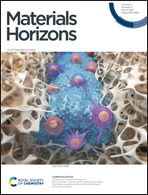Sensing arbitrary contact forces with a flexible porous dielectric elastomer†
Abstract
Artificial tactile sensing in next-generation robots requires the development of flexible sensors for complicated tactile force measurements in both normal and tangential directions. A variety of microstructures have been proposed to be integrated with material development for the enhanced performance of the devices. However, there remains a great challenge in this field on how to decouple contact forces in spatially arbitrary directions with the electric signal readouts. The fundamental correlation between contact force sensing and the microstructure deformations is still largely unknown. Here, we report a new method of arbitrary force deconvolution and sensitive detection of flexible contacts by a porous dielectric elastomer-based force (PDiF) sensor. Decoupling the complicated nonlinear mathematic problem reveals a critical synergy in the porous elastomer between the electrical property enhancement and the geometrical deformations induced by arbitrary contact forces. Proof-of-concept applications in flexible tactile sensing have been demonstrated with the PDiF sensors, including surface roughness discrimination, slippage detection, and real-time force mapping in handwriting. It creates an avenue for flexible sensing of the complicated contact forces with microstructure-embedded elastomeric materials.



 Please wait while we load your content...
Please wait while we load your content...